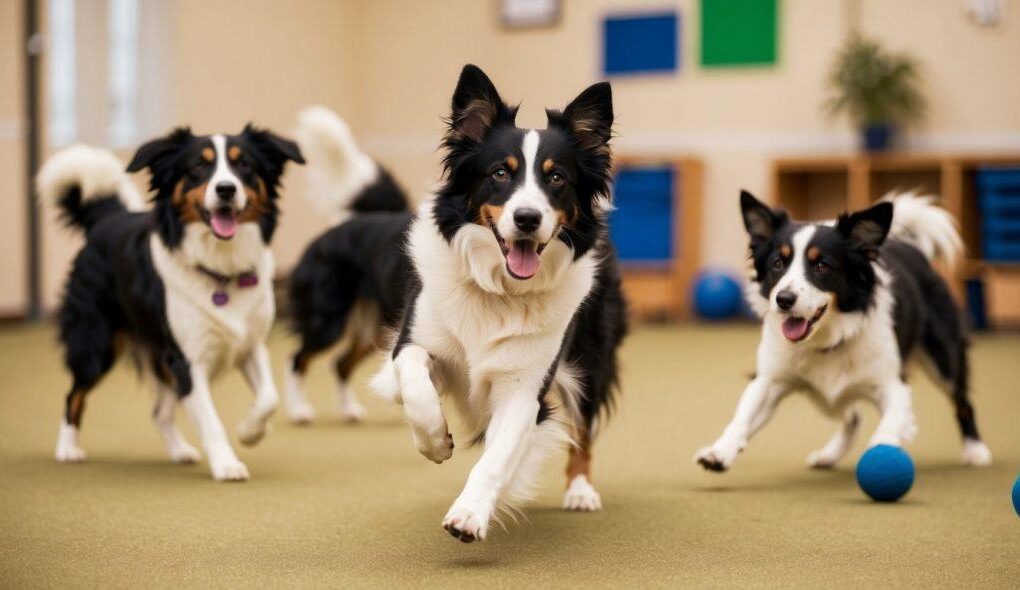Unlocking the potential of a Border Collie is akin to opening a treasure chest filled with intelligence, agility, and boundless energy. Renowned as one of the most intelligent dog breeds, these remarkable canines possess an innate drive to work and learn, making them both a joy and a challenge for owners and trainers alike. Whether you’re a seasoned dog handler or a novice pet owner, understanding the nuances of Border Collie training is essential to harness their capabilities and foster a rewarding partnership. In this article, we will explore effective training techniques, insightful tips, and the underlying psychology of these dynamic dogs, guiding you on the journey to cultivate a well-behaved and fulfilled companion. Join us as we delve into the world of Border Collie training, where every wag of the tail signifies a step towards mastery and mutual understanding.
Table of Contents
- Understanding the Intelligent Nature of Border Collies
- Essentials of Positive Reinforcement Techniques
- Building a Structured Training Routine
- Socialization Strategies for Well-Rounded Companions
- Q&A
- In Summary
Understanding the Intelligent Nature of Border Collies
Border Collies are widely recognized for their extraordinary intelligence and exceptional problem-solving abilities. This breed excels not only in traditional tasks, such as herding livestock, but also in various canine sports and activities. Their strong instinct to work and a natural affinity for learning make them highly trainable. Because of their intelligence, they often pick up commands with remarkable speed, usually requiring only a few repetitions to comprehend a new task. However, this high energy and sharp mind can sometimes lead to unwanted behaviors if their intellectual needs aren’t met, resulting in a challenging, albeit rewarding, training experience.
To harness the intelligence of these remarkable dogs effectively, training should be dynamic and stimulating. Incorporating a variety of training techniques can keep them engaged and prevent boredom. Here are some effective strategies:
- Positive reinforcement: Rewarding desired behaviors with treats, praise, or playtime encourages learning.
- Interactive games: Activities like fetch, hide-and-seek, or agility courses stimulate both their mind and body.
- Socialization: Regular interaction with other dogs and people helps develop well-rounded behavior.
- Mental challenges: Puzzle toys or problem-solving exercises can sharpen their cognitive abilities.
| Training Technique | Benefits |
|---|---|
| Positive Reinforcement | Encourages desired behaviors through rewards. |
| Interactive Games | Keeps the dog physically and mentally stimulated. |
| Socialization | Promotes good behavior around others. |
| Mental Challenges | Enhances problem-solving skills and reduces boredom. |
Essentials of Positive Reinforcement Techniques
Using positive reinforcement during your border collie training sessions can significantly enhance the learning experience for both you and your dog. This method revolves around rewarding desired behaviors rather than punishing undesired ones. It encourages dogs to repeat behaviors that earn them rewards, fostering a strong bond of trust and understanding between you and your furry friend. Consider incorporating various types of rewards to cater to your border collie’s preferences, such as:
- Tasty Treats: High-value treats like small pieces of chicken or cheese work wonders.
- Favorite Toys: A quick play session with a favorite toy can be a great motivator.
- Affection and Praise: Verbal affirmations like “Good boy!” coupled with physical affection reinforce positive behavior.
Moreover, timing is crucial in positive reinforcement; immediate rewards will help your border collie associate the action with the consequence effectively. To enhance this experience, consider using a training schedule that leverages a mix of rewards, such as:
| Behavior | Immediate Reward | Delayed Reward |
|---|---|---|
| Sit | Treat immediately | Playtime after a series of successful sits |
| Come | Praise and a toy | Long walk at the park as a reward for frequent recalls |
Implementing varied rewards and maintaining a positive environment will result in a more engaging training process, allowing your border collie to flourish and enjoy the journey alongside you.
Building a Structured Training Routine
Establishing a consistent training routine is essential for unlocking the potential of your Border Collie. These intelligent and energetic dogs thrive in structured environments where they know what to expect. To build your routine, consider the following components:
- Time Management: Set aside a specific time each day for training sessions, ensuring minimal distractions.
- Session Length: Keep training sessions short but engaging, ideally between 5 to 15 minutes to suit your dog’s attention span.
- Variety of Activities: Mix obedience training, agility tasks, and mental challenges to keep your dog stimulated.
- Positive Reinforcement: Use treats, toys, or praise to reward your Border Collie’s successes and encourage continued effort.
To track your dog’s progress and maintain an organized approach, consider using a simple schedule. This table outlines a balanced weekly training plan designed to enhance your Border Collie’s skills and confidence:
| Day | Activity | Duration |
|---|---|---|
| Monday | Basic Commands | 10 mins |
| Tuesday | Agility Training | 15 mins |
| Wednesday | Leash Walking | 10 mins |
| Thursday | Fetch & Retrieve | 10 mins |
| Friday | Puzzle Games | 15 mins |
| Saturday | Socialization | 30 mins |
| Sunday | Rest Day | N/A |
Socialization Strategies for Well-Rounded Companions
Socializing your Border Collie is fundamental to shaping a well-adjusted companion. This breed is known for its intelligence and energy, making it essential to expose them to various environments and experiences. Incorporate activities that promote positive interactions, like:
- Regular Visits to Dog Parks: These spaces offer controlled environments where your Border Collie can encounter different breeds and temperaments.
- Puppy Classes: Enroll your pup in classes that focus on basic obedience and social skills, teaching them how to communicate with humans and other dogs.
- Public Outings: Take your Border Collie to pet-friendly stores or outdoor events, which can help them acclimatize to crowds and unfamiliar noises.
Additionally, structured playdates can play a vital role in their social development. Try coordinating sessions with dogs that have similar energy levels, ensuring interactions remain positive. Consider the following aspects when arranging these meet-ups:
| Aspect | Details |
|---|---|
| Duration | Begin with 30-minute sessions to prevent overstimulation. |
| Location | Choose a neutral area where neither dog feels territorial. |
| Supervision | Always monitor interactions to manage any unwelcome behaviors. |
Q&A
Q&A: Mastering Border Collie Training
Q: What makes Border Collies so trainable?
A: Border Collies are renowned for their intelligence and eagerness to please. Originally bred for herding, they possess a natural instinct to learn commands and follow instructions. Their problem-solving abilities and high energy levels mean they thrive in stimulating environments that challenge their minds.
Q: What training methods work best for Border Collies?
A: Positive reinforcement is the most effective training method for Border Collies. This involves rewarding desired behaviors with treats, praise, or playtime, reinforcing good behavior while fostering a strong bond between you and your dog. Techniques such as clicker training can also be very effective, as they provide a clear signal when your Border Collie performs a desired action.
Q: How should I start training my Border Collie as a puppy?
A: Begin with the basics. Start with simple commands like ”sit,” “stay,” and “come.” Keep training sessions short—5 to 10 minutes is ideal—to maintain their attention. Socialization is equally important; expose your puppy to different environments, people, and other dogs to help them become well-rounded. Remember, consistency is key!
Q: Are there any specific commands I should prioritize?
A: Yes, start with essential commands such as “sit,” “down,” “stay,” and “leave it.” These commands not only form the foundation for more advanced training but also ensure your dog’s safety in various situations. Once your Border Collie masters the basics, you can move on to more complex commands and tricks.
Q: How much exercise does a Border Collie need?
A: Border Collies are high-energy dogs that require a significant amount of physical and mental stimulation. Aim for at least 1 to 2 hours of exercise daily, which can include walks, playtime, and interactive games like fetch. Incorporating agility training or herding activities can also be a fantastic outlet for their energy and intelligence.
Q: What if my Border Collie seems stubborn or disinterested during training?
A: It’s important to remember that boredom can easily set in with such smart breeds. If your Border Collie appears disinterested, try varying the training routine or incorporating play into your sessions. Keep training fun and engaging by mixing in games, toys, and new challenges to spark their enthusiasm.
Q: How can I manage a Border Collie’s herding instincts during training?
A: Herding instincts are a natural behavior for Border Collies. To manage this during training, redirect their energy into constructive activities such as agility training, obedience exercises, or herding trials. Providing mental stimulation through puzzle toys and interactive games will also help channel their instincts positively.
Q: What are some common mistakes to avoid during Border Collie training?
A: One common mistake is underestimating their intelligence—shoot for mentally stimulating activities rather than just physical ones. Additionally, avoid using harsh training methods, as this can lead to fear and anxiety. Lastly, don’t skip socialization; ensuring your Border Collie is comfortable in various environments is crucial for successful training.
Q: How can I ensure consistent training results?
A: Consistency in commands, rewards, and practice is essential. Make sure everyone in your household uses the same commands and reinforces the same behaviors. Regularly schedule training sessions and incorporate short practice throughout the day. Always celebrate progress, no matter how small!
Q: Is professional training necessary for a Border Collie?
A: While many owners successfully train their Border Collies at home, professional training can be beneficial, especially for first-time dog owners. A professional trainer can provide valuable insights into the breed’s unique needs, help with socialization, and offer guidance on advanced training techniques.
With these insights, training your Border Collie can be a rewarding experience that strengthens your bond and helps your furry friend shine in their natural talents. Happy training!
In Summary
As we wrap up our exploration of border collie training, it’s clear that the journey is as rewarding as it is challenging. These intelligent and energetic dogs thrive on engagement, learning, and companionship, making them some of the most dedicated learners in the canine world. By employing consistent methods, patience, and positive reinforcement, you can unlock your border collie’s potential and shape a bond that goes beyond obedience. Remember, each step taken in training is not just a lesson but a moment of connection and trust between you and your four-legged friend. So, whether you’re embarking on agility courses or simply teaching the basics, let the spirit of adventure guide your training sessions. With time and commitment, you’ll find that the partnership you build with your border collie is a lifelong testament to understanding and mutual respect. Happy training!

